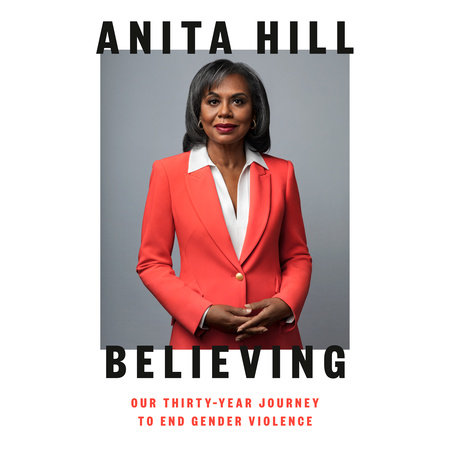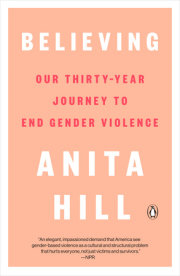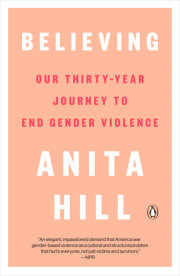one
Our State of Denial
Far too many claims of gender-based violence, whether sexual assault, workplace harassment, or intimate partner abuse, are closed without a meaningful search for the truth. Often, when we do investigate, we ignore facts that are inconvenient, dismissing them as insignificant. Both failing to probe and ignoring the findings reflect a shared state of denial about the pervasive role of gender-based violence in society. And denial is more than an oversight. It is a strategy that employers, politicians, and judges employ to escape assigning accountability for addressing the problem.
Here's an example of how denial works in terms of women's health. Imagine waking up one morning with pain in your neck, jaw, back, and arms, as well as nausea, sweating, shortness of breath, and light-headedness. You call your doctor hoping to get an appointment right away, but instead he suggests that you may be suffering from anxiety. He recommends that you take an over-the-counter drug like Tums or Prilosec for the stomach problem or Tylenol for your neck and jaw pain. He insists that what you describe "doesn't appear to be too bad-nothing that a few days of rest shouldn't take care of." Your doctor is missing the symptoms of a possible heart attack. I hope you've never encountered this kind of treatment, but unfortunately others have. In the first decade of the twenty-first century, researchers discovered that women were at high risk for misdiagnosed, mistreated, or untreated cardiac arrests, in part because doctors were looking for symptoms that were more common to men-chest pain and pain in the left arm. But another element was the assumption that women were overreacting to their health concerns. As a result of social and medical biases, tests that could have revealed women's heart ailments were never prescribed. Instead, women's cardiac arrests were dismissed as heartburn or a panic attack. Women weren't getting the same quality of treatment as men, the treatment they deserved. The gender gap in treating heart disease is not new. And more than a decade after it was discovered, the gap continues to exist. As a result, women are dying or suffering from life-threatening conditions because they didn't get the proper diagnosis and treatment.
The gender gap in taking women's health concerns seriously isn't limited to heart conditions, as shown in an episode that took place at the Indiana University Health North Hospital. In 2020, in a video posted on Facebook, a Black woman physician, Dr. Susan Moore, complained that a White doctor who was treating her for COVID-19 denied her request for pain medication. Not taking Moore's word about the level of pain she suffered, he challenged her to prove that she was in as much distress as she claimed. And instead of the treatment she asked for, he recommended she be sent home. Moore eventually was treated for pain, but not as she had requested. About two weeks later, Moore died from complications of the coronavirus infection. Following a preliminary review of the case, the hospital's CEO expressed his full confidence in the "technical aspects of the delivery of Dr. Moore's care." However, he called for an external review and expressed concern that the medical team "may not have shown the level of compassion and respect we strive for in understanding what matters most to patients." So would an external review tell us why Dr. Moore didn't receive the "compassion and respect" she believed she deserved? Perhaps. Moore had attributed the rebuff to racism. But the brush-off she got could have stemmed from sexism or from racism and sexism combined. A similar disregard occurs when women complain about workplace sexual harassment and assault. And most organizations review their complaint-handling processes internally, even when there are multiple accusations against an individual. As with health issues, sexism, organizational loyalty, and a host of other biases lead some internal investigators to disrespect women who complain. Far too often, concerns go uninvestigated or are shoddily probed and dismissed as insignificant. And as with prejudging women's ability to communicate their medical conditions, when we discount women's credibility to describe gender violence, the outcomes are the same. Women suffer-regardless of whether the prejudice is overt or implicit.
"But I Don't Know the Facts"
The very first national attempt to get the facts about sexual harassment in the workplace did not come from federal agencies. In 1976, after hearing about readers' experiences, the popular women's magazine Redbook conducted a survey of nine thousand women, the first of its kind to explore the reality of women's workplace experiences. The magazine's report on the findings was called "What Men Do to Women on the Job." Redbook called the findings "eye-opening." Between ads for Dynamo and Ivory detergents and Arthur Murray dance lessons were accounts of sexual comments, groping, leering, extortion, and more. More than eight thousand of the women who responded said they had experienced at least one form of sexual harassment. Claire Safran, the article's author, concluded that the problem was "a pandemic-an everyday, everywhere occurrence."
Five years after hearing from women employees, Redbook teamed up with the Harvard Business Review to collect business executives' views on sexual harassment in American workplaces. The following are three telling responses from the two thousand men and women who participated in the follow-up study.
"In my own circumstances, sexual harassment included jokes about my anatomy, off-color remarks, sly innuendo in front of customers-in short, turning everything and anything into a sexual reference was an almost daily occurrence," said a thirty-four-year-old first-level female manager in environmental engineering for a large producer of industrial goods. "I have just left this company [a big chemical manufacturer] partially for this reason," she added.
Another person, a fifty-three-year-old man who was a vice president at a medium-sized financial firm, said he was skeptical about sexual harassment existing within his company. "I used to believe it was a subject that was being exaggerated by paranoid women and sensational journalists," he said. "Now I think the problem is real but somewhat overdrawn. My impression is that my own company is relatively free of sexual harassment. But I don't know the facts."
"This entire subject is a perfect example of a minor special interest group's ability to blow up any 'issue' to a level of importance which in no way relates to the reality of the world in which we live and work," said another man, a thirty-eight-year-old plant manager for a large manufacturer of industrial goods.
In the 1981 survey, 88 percent said that sexual relations, even consensual ones, had "no business in the business world," and 78 percent called propositions to swap sex for good performance reviews sexual harassment. The three statements above offer just a glimpse of what the business world thought of harassing behavior. Each sentence describes either a firsthand experience with harassment, reactions to harassing behavior, questions about its significance, or denials of its existence. Which of these perceptions accurately reflect reality in 1981? The truth is that they all do, and the comments can serve as a starting point for determining where we are today.
Why begin this book with a Redbook poll? Because many of the same experiences and attitudes expressed in 1981 still exist. Also, it's telling that before Redbook, a women's magazine, conducted its initial survey in 1976, no other broad inquiry into sexual harassment existed. And the survey had its limitations. The majority of the women who responded to the poll held white-collar jobs. There was limited information collected on the experiences of those working in private households, food service, agriculture, or other low-wage positions. The federal government only began to collect data in 1981, when Congress asked the U.S. Merit Systems Protection Board to conduct two surveys. By then, the Equal Employment Opportunity Commission was beginning to develop policies to eliminate the problem. Two studies conducted by the MSPB in the 1980s found that workers in federal offices and installations widely perceived sexual harassment to be a problem. Far too often investigations were inadequate, and nothing was being done to fix their shortcomings. Getting a clear picture of sexual harassment and how effective prohibitions might have been requires us, at the very least, to see it from the point of view of each participant: the female supervisor, the male company vice president, and the middle manager, generally also a man. Who is most likely to have experienced harassment? Who is likely to have committed it? Who is most likely to be held accountable for a company's failure to stop it? Whose job is most likely to be on the line if they are found to have committed harassment or reported it? The bottom line is that without more information we couldn't be entirely sure of our answers. That's why the vice president who said, "I don't know the facts," but was still willing to reach a conclusion is in my opinion the most troubling respondent. Not knowing the answer to the question of whether sexual harassment exists doesn't necessarily disqualify him from leading a modern workplace, where rules to end harassment are starting to be enforced, but not using his status to find the answer does. His is a classic denial. His motives seem clear. His apparent interest is in protecting his company rather than learning what goes on inside it and addressing it. It's a familiar stance.
AQ: 1976 meant, right? That was the year of the Redbook poll. The Harvard Business Review poll was the one done in 1981.
Making Harassment Illegal
Early sexual harassment cases show that the manager's and the vice president's views of the problem of sexual harassment were typical. And the female manager's decision to leave was also predictable. In the decades before the Thomas hearing, courts routinely rejected the idea that women had any right to complain about the sexual comments, groping, leering, extortion, and exploitation that Redbook uncovered. Some courts excused the behavior as natural and expected:
The abuse of authority by supervisors of either sex for personal purposes is an unhappy and recurrent feature of our social experience. . . . It is not, however, sex discrimination within the meaning of Title VII, even when the purpose is sexual.
-federal judge herbert jay stern, tomkins v. public service electric and gas company (1976)
Before working on the landmark Alexander v. Yale University case in 1980, which argued that sexual harassment violated students' rights under Title IX, Catharine MacKinnon, a student at Yale Law School, was already at work developing her theory explaining why the sexual harassment facing women in the workplace was a form of sex discrimination that violated Title VII of the Civil Rights Act of 1964. Lawsuits filed in the 1970s showed her that getting courts to rule that harassment was a violation of the law would be a laborious undertaking. Yet the decade saw other activism around the issue of sexual harassment. Eleanor Holmes Norton, head of the New York City Commission on Human Rights, convened the first government hearings on the behavior in 1975. Carmita Wood, an administrative assistant at Cornell University who had filed a claim against her employer, testified before the commission's hearings on women and work. Lin Farley, who was supporting Wood and others who had harassment claims, also testified. Farley is credited for coining the term "sexual harassment" for behavior that results in women losing their jobs for saying no to "sexual byplay."
At the same time, in Boston, the business consultant Freada Kapor Klein started her early work on what she termed "sexual extortion." Klein's expertise was her pioneering prevention efforts, working with businesses to detect and address factors before violations occurred. Despite this growing awareness of the problem and attempts to elevate it to both social and legal consciousness, harassment went largely unchecked. Between 1986 and 1989, a number of state task force surveys questioned women in the legal profession about their experiences with harassment. Professor Marina Angel, who analyzed the surveys, found that women lawyers in several states had witnessed judges soliciting "sexual favors from [women who came before the courts, including] criminal defendants, civil litigants, lawyers (including prosecutors, public defenders, and private counsel), law clerks, law students, court employees, job applicants, probation officers, juvenile court wards, and jurors." Yet rarely was the conduct found to have violated state codes of judicial conduct.
Under the Civil Rights Act of 1964 and its 1972 amendments, sexual harassment is defined as persistent or severe, unwelcome or unwanted sexual behavior. By the late 1970s, MacKinnon had framed the legal concept to enshrine two new categories of behavior. They are quid pro quo, sex in exchange for employment, pay raises, promotions, and so on, and what would be called "hostile environment sexual harassment," which refers to persistent and pervasive harassment, such that the workplace becomes tainted and negatively impacts a worker's ability to do their job.
But MacKinnon's successful attempt to advance these concepts into law was fraught. Some courts rejected the idea outright. This is not surprising. There was considerable evidence that some male judges' perspectives cause them to view women's experiences very differently than women might.
If any theory were going to test male judges' bias inside the judicial process, the legal validity of sexual harassment was it. In the 1970s, when MacKinnon was arguing for courts to recognize this new idea that sexual harassment constituted discrimination, judges routinely rejected her position. A slew of decisions by male judges demonstrated a deep, culturally loaded resistance to acknowledging the cause of action. They denied that the facts parties alleged amounted to a legal violation no matter how vivid and horrific or accurately they described reality in the complainants' workplaces.
To justify turning away complaints, judges would either characterize sexual exploitation as "normal" or too common for the law to curtail, or they'd argue that such behavior is a result of biology and cultural inevitability (that is, boys will be boys). These personal assessments of the behavior clouded judges' abilities to imagine the legal harm it caused to the women who suffered from it.
Take, for example, one of the earliest decisions in this vein, that of Judge William C. Frey in the 1975 case Corne v. Bausch and Lomb. Judge Frey was in the U.S. Army as a major during World War II. He left the military, went to law school, and practiced law in a private firm before serving as an assistant Arizona state attorney general. While Frey was serving as a county superior court judge, President Richard Nixon nominated him for a position on the federal bench. Six years later he wrote the opinion in the Corne decision, the first sexual harassment case to reach a federal court. Jane Corne and Geneva DeVane, two administrative assistants at Bausch and Lomb, an eye product company based in Canada, brought the suit, charging that their supervisor, a man named Leon Price, repeatedly took unsolicited and unwelcome sexual liberties with them and other female employees. The advances were verbal as well as physical and eventually escalated to a level that both Corne and DeVane found intolerable. They left Bausch and Lomb and sued their supervisor and the company. A Nixon appointee, Judge Frey was well liked across ideological lines. He was friends with the Arizona Democratic senator Dennis DeConcini and Representative Morris K. Udall, a Democrat from Arizona. And "despite political differences," in a memorial to Judge Frey upon his death a few years after the Corne decision, Udall applauded the jurist's "mastery of the art of judging" for his handling of a highly "emotional Arizona busing case."
Copyright © 2021 by Anita Hill. All rights reserved. No part of this excerpt may be reproduced or reprinted without permission in writing from the publisher.










